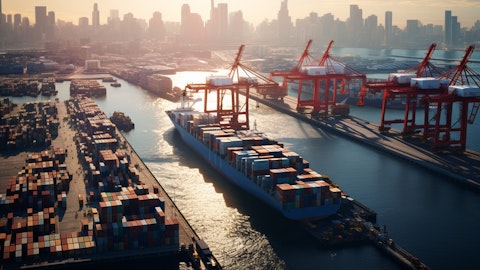Companhia Energética de Minas Gerais (NYSE:CIG) Q3 2025 Earnings Call Transcript November 14, 2025
Carolina Senna: Good afternoon, everyone. I am Carolina Sena, Cemig’s IR Superintendent. Welcome to Cemig’s Third Quarter 2025 Earnings Video Conference Call. This video conference is being recorded, and it will be available on the company’s IR website at ri.cemig.com.br, where you also find the full package on our earnings call. [Operator Instructions] We will now start Cemig’s video conference call with Reynaldo Passanezi Filho, CEO; Andrea Marques de Almeida, CFO and IR Officer; Luis Cláudio Correa Villani, Chief Information Officer; Sergio Lopes Cabral, Chief Commercialization Officer; Sérgio Pessoa de Paula Castro, Chief Legal Officer; Carlos Camargo de Colón, Gasmig’s CEO; Iuri Araújo de Mendonça, Cemig SIM’s CEO. For their initial remarks, I turn the floor over to our CEO, Reynaldo Passanezi Filho.
Reynaldo Filho: Good afternoon, everyone. Welcome to our earnings call for the third quarter. It’s always an opportunity and a pleasure to be able to bring to you our results and our efforts in another quarter. This is a quarter in which we have more difficult news. Of course, I would like to highlight some important topics that show the strength and the resilience of Cemig’s earnings. About specific news on the quarter, we had distribution results that were affected by large clients that left the network. They migrated to the basic network about trading. We tried to decrease some positions. Also, that involves the submarket prices that have affected the results. What’s important, and you know that when we look at our net position, it is very favorable in the scenario that we have for pricing today.

The same thing happened with generation because of the difference in the GSF and the need to offset that with the spot price. This is what I would like to highlight. And despite of these topics, we moved on with a recurring EBITDA, proving the company’s resilience, and we have confirmed the AAA rating by Moody’s. We have 2 agencies now guaranteeing us a AAA rating, showing our resilience capacity to any type of scenario. We also had an award by a magazine called Veja Negócios, as the best energy company in Brazil in the top 30 award. And we also had the approval of our health care plan for retired employees. So we finalized a collective agreement with the union and that allows us to look for a positive structural solution that will preserve a positive transition to all of us.
Therefore, they can keep their health care plan and also we’ll be able to guarantee the company’s sustainability. And the final topic, and Andrea is going to go over the details, which is our investment program. We are, once again, making the largest investment program in the company. For this quarter, we have BRL 4.7 billion, a significant increase when compared to last year. I believe we have a very positive message here, and we are maintaining our investment plan. And that means very positive results for the tariff review situation when that comes. So here, we have BRL 3.6 billion in distribution by itself. If we multiply that by the WACC, we know that the results bring additional revenue of a little over BRL 500 million just for that 9 months.
So these are very cautious investments in regulated areas that when they get mature and the agency recognizes that we are going to have very positive results for the company. This is what allows us to have resilience today, and this is what allows us to have very positive results in the future, whether by these investments or by a very favorable position in the trading business in the near future. These are my initial remarks. Obviously, we are here to take your questions after the company’s presentation. I’ll turn the floor to Andrea, but I would like to stress the strength of this company and that we are very confident that we are going to move on with this investment plan and maintain the company’s debt levels and the covenants and therefore, to keep on investing, keep on generating value.
Q&A Session
Follow Companhia Energetica De Minas Gerais (NYSE:CIG)
Follow Companhia Energetica De Minas Gerais (NYSE:CIG)
Receive real-time insider trading and news alerts
And this is going to get more mature according to the regulations and tariff regulations as expected. Thank you very much.
Andrea de Almeida: Good afternoon, everyone. It’s also a pleasure to be here with all of you today, going over our third quarter earnings. Now moving on, talking about our investments, as Reynaldo mentioned, we invested in the 9 months of 2025, BRL 4.7 billion. And this is how they break down BRL 3.6 billion in distribution, focused obviously in substations. This is a milestone and we have some pictures to show you the substations that we had in the quarter, but also 5,349 kilometers of low and medium voltage networks, which are very important to bring good service to Minas Gerais. For generation, we also mentioned our participation in the GSF credit auction with BRL 199 million. That’s very nice. It guaranteed the extension of our concession in some of our plants.
But also we had investments of BRL 149 million in expansion and maintenance. For transmission, we have our Verona project, around BRL 30 million, and we are still investing in reinforcements and improvements, and we are going to mention some of those and how the allowed annual revenue is performing in transmission. For Gasmig, the centralized project is the most representative one, around BRL 180 million being invested in the project. And for Cemig SIM, the delivery of new photovoltaic plants and 31 megawatts of installed capacity. Moving forward, we have the pictures of the 5 new substations, the ones this quarter, Andrelndia, Coronel Xavier Chaves, João Pinheiro, São Tiago, Fronteira. These are our highlights of new substations for distribution.
Now turning to transmission. We see where in our operation we had improvements: Taquaril, Três Marias, São Simão, Itajubá, Volta Grande, Lafaiete. And we were able to add over the year, BRL 32 million of allowed annual revenue in our transmission business. And of course, this brings great results as well. Moving over to the figures. As Reynaldo mentioned, we have BRL 1.5 billion of EBITDA, and we see a drop in our EBITDA in around 16.3% when we analyze the recurring EBITDA, and I will talk about the recurring numbers, and then I’ll talk about the nonrecurring events of last year, which were significant. We can talk about them as well. In generation, we already mentioned we had the effects of a lower GSF. We had to buy energy to cover for the GSF.
So we had an impact of BRL 54 million. In the trading business, there was an impact here. And we already had the reduction in margin in the trading comparing ’24 to ’25. And we ended positions. We closed positions and of course, came from our exposure and other positions that were also open. So the closing of these positions and the purchasing of energy and the prices — the spot prices that we have seen ended up having this impact of BRL 136 million for distribution. In ’24, we had a change in the methodology, which was a reversal of our ADA and that reverted how we provisioned our ADA. We didn’t have that in 2025. Therefore, there is a negative delta effect in distribution. And you will see that the market also has reduced it. And as Reynaldo mentioned, some clients left and went to the basic network.
Therefore, this impacted distribution. Now turning to our net profit, the major investment that we are making has a greater depreciation impact than the funding, the increase of the interest rates, and of course, the increase of leverage of the debt also affects our net profit, the recurring net profit, and we realized that there was this drop of around 30.2%. For nonrecurring effects of last year, just let me remind you, they were very relevant. We had BRL 1.6 billion of the disposal of Aliança last year. Of course, this is not happening this year, and the tariff review for the transmission business of BRL 1.5 billion. These did not show in 2025. That’s why we have also this relevant delta here. Let’s move on. Here, zooming in, in GSF, when we compare GSF of 2024, we see the performance of July and September.
GSF for 2024 going from 0.8 to up to 0.7. So we did have to purchase to deal with the hydrological risk and also the level of the energy price that we see this year. Of course, higher levels than what we have seen last year. Just September of last year, we had higher prices than this year, as you can check in the charts. So this is the impact. Now operating costs and expenses. We are growing below the inflation rate. And outsourced services, which is what draws our attention, we have an increase in areas where distribution has to invest more efforts to guarantee the improvement of services, whether maintaining, installations or in technology, and we still are working on the improvement with smart meters. We have to invest in that. And we have to fund technology.
We have to prune trees and also clear the pathway. So that’s where we have a higher increase in other expenses. Also, we had the sale of a plot. For personnel, we see a performance — a good performance here. But here, we have in-sourcing of employees. We are bringing in our own teams so that we can cater to our clients faster in specific regions. And we really want to be more efficient in our service in regions. And we know that Minas Gerais is a largest state. So we want to be quicker serving further away areas. So we have an increase here in personnel in our headcount. Moving on, in line with our capital structure, we, yes, need the debt to fund our investments, but our leverage is at very safe levels. We are at 1.76 or net debt over recurring EBITDA.
That’s why we have our best rating in history. As Reynaldo mentioned, two AAAs and one AA+, and we are structuring our debt in a way to increase the average tenure. We reached 5.7 with the average term — as average term. And the cost performance, we see the fact of the high cost of the interest rates, which affect all of us in the market and as well as Cemig, of course. Now for our cash flow. This is how we have been financing our activity, our investments. We start with cash. This is for 9 months, okay? So we start with cash of 2024 at BRL 2.3 billion. We have cash from operations of BRL 3.4 billion. We have the debentures issuance in May of BRL 5.1 billion, the debentures payments, of course, obviously. These are prior debentures of BRL 2.4 billion.
Dividends and IOC, BRL 1.7 billion. Our activities for investments of BRL 4.5 billion. Earmarked funds here, BRL 187 million. We have to have this amount aside. So we come to our final cash of BRL 2.3 billion. For Cemig D, everything is more or less explained already. But effectively, we show a drop in EBITDA of 4.7%, especially because of the market reduction, whether it is by economic activity, once it’s not that positive and also the temperature that was mild and the market dropped. Once again, the client that has migrated in the second quarter to the basic network. And of course, now in the third quarter, we see the full impact of this migration. In addition to that, we have the reversal of the constitution that I said of the ADA, as I mentioned before.
And of course, in the net profit for Cemig D, we see the effect of our fundings and also the interest rates affecting that result. Talking a little bit now about the energy market. We had a drop of 4.4%, and we see the full effect in all the different markets and our distributing company coming from the rural, commercial, industrial, all the effects coming from all the markets. And in fact, here, we see this drop being caused by this client that has migrated for the basic network. Our operating indicators show that our collection is still very strong, focusing in the digital channels and Pix, our payment method is the cheapest. And now we are going to have the auto Pix as well. And we will be able to have campaigns so that people choose this payment mode, which helps us all and also reduces our costs.
And this is growing as a good option of payment. And now our ARFA, the receivables collection index is at good, stable levels, and our regulatory OpEx and EBITDA show that we are within the regulatory standards. In terms of regulatory losses, we are also within the standards. There was a change in the criteria which already happened. We are now are integrating the effects of micro and mini generations that are distributed. So we are continuing to work. We have always keep working on losses. We have to install the armored meeting panels. We have to install the smart meters. And all the actions that we have to keep on taking so that this indicator is within the regulatory limits. For Cemig GT, once again, we talked about it. GSF was the main impact.
We had to purchase energy to tackle the hydrological risk and the recurring net profit. Here, you can see the results as well. And Cemig GT was the one that had the main nonrecurring effects from 2024. So the major impacts are there represented last year. Therefore, we had a higher EBITDA in 2024 effects that are not replicated in 2025. And Gasmig, that also had impact for EBITDA reduction because there was a drop of 6% in the market and also the clients that migrated to the free market. This, once again, effect on Gasmig. And on this page, we have Cemig’s recognitions. Reynaldo already mentioned, and that we are very proud to be recognized as the best energy company in Brazil by Veja Negócios. And there are other recognitions. We are also recognized as the best financial team in the infrastructure and energy sector by FILASA.
We also got the transparency award from ANEFAC. We have always room to improve, but it’s already great to be recognized by the 19th time by ANEFAC. And there is a new one, the ESG award. Cemig has thousands of awards in sustainability. And we are very proud, and it’s always great to have another one. So ESG from ANEFAC in this category, Transformative Internship category. Therefore, I end my presentation, and I turn the floor back to Carol to ask — to open the Q&A session and take your questions.
Carolina Senna: [Operator Instructions] Our first question is from Victor Sousa, Genial Investimentos.
Vitor Sousa: Hello, can you hear us?
Carolina Senna: Yes, we can hear you, Victor. Go ahead.
Vitor Sousa: My question is about Technical Note 53 that changes how you post losses in the distribution sector. I would like to understand if there is a possibility of republishing the level of losses that Cemig had. Now looking backwards here, I would like to understand if this change can end up generating any accounting retroactive effect regarding the application of this technical note if your concerned amount receivables, provisions and other adjustments, or is this just a prospective impact, just an accounting impact? And another question still on this note. How would have been the level of losses for distribution if this technical note did not exist? So in the same comparison base, what would have been the performance of Cemig losses? Would they have increased, decreased, or they would have been the same? I think this is important to understand for the process of assessing the distributing companies.
Reynaldo Filho: Thank you, Vitor, for your question. Denis Mollica, our Strategy, Innovation and Sustainability Officer. Please, Dennis.
Denis Mollica: Thank you for your question, Vitor. About the method used for calculation of losses. The method, even having it being reviewed, it does not — it’s not applied to past calculations. Even if we were to simulate that in the prior losses and the older losses, we would still be within the limits. So for practical accounting effects, adjustments have done from now on. And as it was said already, we are still within the regulatory losses, both before and after this technical note. So we have major actions to manage and to fight our losses, and they are within the limits with no effects that might affect accounting at all. And of course, yes, we also have here a positive effect on the tariff once we have the recognition of the impacts of the DG in the method of calculating losses.
Carolina Senna: [Operator Instructions] Our next question is from Luiza Candiota from Banco Itaú.
Luiza Candiota: It is about your trading strategy. Analyzing the changes in the energy balance in this quarter compared to the prior one. I would like to go over the details of the rationale regarding the short exposure when we look at ’25, ’26 and ’28. What could be explaining this change that we see?
Reynaldo Filho: Thank you, Luiza. I’ll turn the floor to our Chief Trading Officer, Sergio Lopes.
Sergio Cabral: First, thank you for your question. We have been doing a great effort to close our positions. Of course, we have some marginal sales that we are executing with clients that are strategic, but our position is not to open more positions. We want to close, as Andrea has mentioned. For this quarter, we could close positions in these past months. And also, we have the impact of gold that ended up making us go to the market to buy energy, but we are not opening positions. We are rather than that closing them.
Carolina Senna: There are no further questions. We thank you all very much for your participation. And the superintendents of IR is available to take any other questions you might have. Therefore, we end Cemig’s third call — video conference call. Have a nice afternoon, and thank you very much.
Follow Companhia Energetica De Minas Gerais (NYSE:CIG)
Follow Companhia Energetica De Minas Gerais (NYSE:CIG)
Receive real-time insider trading and news alerts




